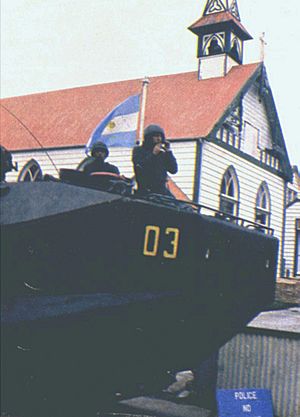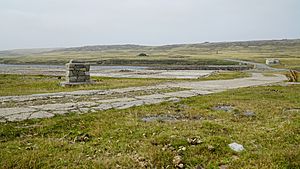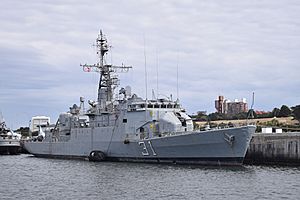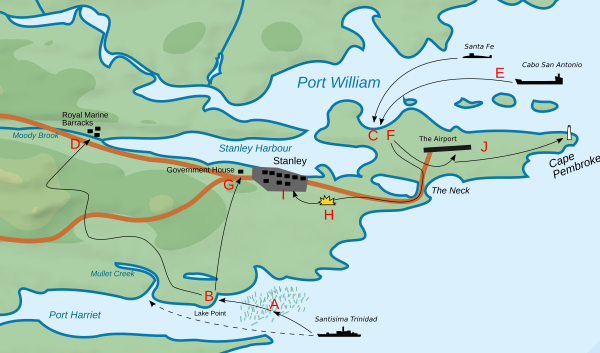1982 invasion of the Falkland Islands facts for kids
Quick facts for kids Invasion of the Falkland Islands |
|||||||
|---|---|---|---|---|---|---|---|
| Part of the Falklands War | |||||||
 Argentine naval infantry AAV in Stanley |
|||||||
|
|||||||
| Belligerents | |||||||
| Commanders and leaders | |||||||
|
Rear Admiral Carlos Büsser | ||||||
| Units involved | |||||||
|
Argentine Navy
|
||||||
| Strength | |||||||
|
|
||||||
| Casualties and losses | |||||||
| 107 captured |
|
||||||
The Invasion of the Falkland Islands (Spanish: Invasión de las Islas Malvinas), also known as Operation Rosario, was a military attack by Argentine forces. It happened on April 2, 1982, to take control of the Falkland Islands. This event was the main reason the Falklands War started soon after. Argentine troops landed on the islands, and the invasion ended when the British forces at Falkland Government House surrendered.
Contents
Defending the Islands
On April 1, 1982, the British Government told Governor Rex Hunt that Argentina might invade.
Who Defended the Falklands?
Governor Hunt called the two highest-ranking Royal Marines in Stanley to Government House. They talked about how to defend the islands. Major Mike Norman was put in charge of the Marines. Major Gary Noott became Governor Hunt's military advisor.
There were 68 Marines and 11 sailors from the ship Endurance. This number was higher than usual because new troops were arriving, and old ones were still there. So, there were more defenders than expected.
Some Marines left to watch Argentine soldiers on South Georgia. This reduced the number of Marines in Stanley to 57. The Royal Navy and author Russell Phillips say there were 85 Marines in Stanley.
About 25 members of the Falkland Islands Defence Force (FIDF) also joined the defense. Some reports say up to 40 FIDF members helped. Their leader, Major Phil Summers, told these volunteer soldiers to guard important places. These included the telephone exchange, the radio station, and the power station.
A civilian boat, Forrest, helped by acting as a radar station. Four other civilians also offered to help the governor. Governor Hunt himself carried a pistol.
Before the main Argentine landing, nine British sailors gathered 30 Argentine people living in Port Stanley. They kept them safe near the Police Station. These sailors then went back to Government House to help.
Operation Rosario Begins
The Argentine attack started late on April 1. A destroyer, ARA Santísima Trinidad, dropped off special forces south of Stanley. The main Argentine force was supposed to land later. They would come from the ship ARA Cabo San Antonio near the airport. Frogmen from the submarine ARA Santa Fe had already marked the beach. The operation was first called Azul (Blue) but was renamed Rosario.
The Submarine ARA Santa Fe
Operation Rosario began with the submarine ARA Santa Fe checking Port William. It then landed 14 members of the Buzos Tácticos (Tactical Divers) near Cape Pembroke. Their leader was Lieutenant-Commander Alfredo Raúl Cufré.
The submarine had spotted a fishing boat on March 31. The next day, Santa Fe learned that the British knew about their plans. So, they changed their landing spot slightly.
The commandos left Santa Fe at 1:40 a.m. They used Zodiac boats to reach Yorke Bay by 4:30 a.m. on April 2. They set up beacons for the main landing. Then, they took over the airfield and the lighthouse easily. After the British surrendered, this team gathered the Royal Marines.
Attack on Moody Brook Barracks
On the night of April 1–2, 1982, Santísima Trinidad stopped close to Mullet Creek. It launched 21 small boats carrying 84 special forces soldiers. These were from Lieutenant-Commander Guillermo Sánchez-Sabarots's 1st Amphibious Commandos Group. A small group led by Lieutenant-Commander Pedro Giachino also went to capture Government House.
Argentine Rear Admiral Jorge Allara asked Governor Rex Hunt to surrender peacefully. But the governor refused.
Giachino's group had a shorter distance to travel. The main group went towards Moody Brook Barracks, which was about 6 miles away.
The Argentine Marines thought Royal Marines were sleeping in the barracks. The barracks were quiet, with only one light on. No guards were seen. Sánchez-Sabarots heard nothing from Government House or the landing beaches. He ordered the attack to begin.
The sound of grenades warned Major Norman that Argentines were on the island. He quickly drove back to Government House. He realized the attack was at Moody Brook. He ordered all British troops to gather at Government House for a stronger defense. Most of the Falkland Islands Defence Force also went to their Drill Hall.
Sergeant Gerald Cheek from the FIDF remembered being told not to fight the enemy. They were to surrender if ordered.
British descriptions of Moody Brook barracks after the attack were different from the Argentine version. Royal Marines later saw the barracks walls full of machine gun holes. They also saw marks from white phosphorus grenades. This suggested a strong attack. The Argentines say the barracks were destroyed later by British planes.
Landing at Yorke Bay
More action happened on the eastern side of Stanley. Twenty LVTP-7A1 armored vehicles landed at Yorke Bay. They came from the ship ARA Cabo San Antonio. A group of Royal Marines led by Lieutenant Bill Trollope watched them. Two Argentine landing craft also landed later that morning.
The armored vehicles drove along Airport Road into Stanley. Three vehicles were in front. Near the Ionospheric Research Station, at 7:15 a.m., Royal Marines attacked them. They used anti-tank rockets and machine guns.
One Argentine vehicle moved off the road and dropped off its Marines. One Marine, Private Horacio Tello, was wounded. The Royal Marines thought they had hit the vehicle directly. According to Argentine reports, this vehicle was hit 97 times. Another vehicle lost its tracks.
Lieutenant Trollope described the fight. Six armored vehicles came quickly down Airport Road. The first one was hit by rockets. Both rockets exploded. No fire came back from that vehicle. The other five vehicles, further away, dropped their troops and started firing. The Royal Marines fired back for about a minute. Then, they used a smoke grenade and moved back to cover. The incoming fire was heavy but not very accurate.
Governor Hunt wrote that Marines Brown and Betts stopped the first vehicle. Marine Gibbs hit the passenger part. Hunt said, "They stood ready to shoot anybody who got out, but nobody did."
Trollope and his men moved back through Davis Street. They ran behind houses with Argentine Marines chasing them. They kept firing but realized they could not reach Government House. Corporal Lou Armour's group was at Hookers Point when the invasion started. After the Moody Brook attack, they were told to go to Government House.
Armour's group tried to get to Government House. They used fire and movement to cross a football field. They crawled along a hedge leading to the gardens. They even got hit by their own side, who thought they were Argentines. Armour said, "An Argentine was killed that day and a few more wounded."
They finally got inside through the kitchen door. Armour said they were then sent upstairs by Major Noott.
Meanwhile, Corporal Stefan York and his group were watching from Navy Point. When Argentine landing craft came into Stanley Harbour, Marine Rick Overall fired an anti-tank round. The British claimed it sank an Argentine landing craft, killing everyone inside. However, Argentine reports say an armored recovery vehicle entered the harbor later to fix damaged vehicles. A local fireman saw one vehicle having trouble with a track.
Major Mike Norman wrote that if a landing craft had been sunk, he would have known. His group was in constant radio contact. No such event was ever mentioned.
Battle for Government House
Lieutenant-Commander Pedro Giachino was on a small hill near Government House. He had only sixteen men and no radio. He split his force into small groups to attack the house from different sides. He did not know that Government House was where most of the Royal Marines were gathered. The Marines outnumbered his group by more than two to one.
The first attack on the house was at 6:30 a.m. One of Giachino's groups, led by Lieutenant Gustavo Adolfo Lugo, started shooting at the British inside. At the same time, Giachino and four others went into the servants' area. They thought it was the back entrance. Four Royal Marines covering this area stopped the first attack. Giachino was shot as he entered, and Lieutenant Diego Garcia Quiroga was shot in the arm. The remaining three retreated.
Giachino was badly wounded. An Argentine medic, Corporal Ernesto Urbina, tried to reach him but was also wounded by a grenade. Giachino, seeing this, pulled the pin from a grenade. He threatened to use it, stopping the Royal Marines from helping him. After the British surrendered three hours later, Giachino was taken to Stanley Hospital but died from blood loss.
At the governor's office, Major Norman got a radio report from Corporal York's group. They were watching Stanley Harbour. York reported three possible targets and asked which to attack first. He said, "Target number one is an aircraft carrier, target number two is a cruiser." Then the radio went dead.
After firing a rocket at a vehicle, York decided to pull his group back. He booby-trapped their anti-tank rifle. They then paddled their boat across Port William. York said an Argentine destroyer chased and fired at them. His group hid their boat under a Polish fishing vessel. They waited, then landed on a small beach. Argentine sources say the Drummond fired at a cove where unknown people were seen.
Back at Government House, the Argentine commandos kept up the pressure. They used stun grenades and moved their firing positions often. This made the Royal Marines think they were facing a much larger force. But after Giachino's group failed, only about a dozen commandos, led by Lieutenant Lugo, surrounded the British. The Royal Marines' vehicles were damaged by gunfire.
Governor Hunt called the radio station, Radio Stanley. He said he thought the attacking force was very large. He said they were "pinned down" and couldn't move. He thought there were 200 Argentines around them, throwing grenades.
Corporals Geordie Gill and Terry Pares, who were snipers, said they shot several Argentines. They claimed to have killed or wounded four or five Argentine special forces.
Official records state one Argentine was killed and three were badly wounded outside Government House. Three other Argentine Marines were injured in skirmishes around Port Stanley. A British reporter, Kenneth Clarke, was near Government House. He heard gunfire and explosions. A bullet from an Argentine sniper came through a window near him.
Around 7:30 a.m., the local police commander, Ronnie Lamb, sent officers to rescue a civilian who was walking to work. Governor Hunt decided to talk with Argentine commanders around 8:30 a.m. Major Norman told him their defense would be strong but short. Vice-Commodore Hector Gilobert, head of the Argentine airline, acted as a go-between. Gilobert and a governor's deputy went to the Argentine headquarters with a white flag. A ceasefire began, though there was still some small arms fire.
The governor's envoys found the Argentine command post at Stanley's town hall. The Argentine commander agreed to meet Hunt. While talks were happening, three Argentine commandos inside the residence were discovered by Major Noott. He fired his submachine gun. The commandos then surrendered. They became the first Argentine prisoners of war.
Lieutenant Commander Cufré said the three commandos stayed in position until the end. Admiral Carlos Büsser, the operation commander, said a ceasefire was in place. The commandos surrendered to help the wounded. Government House surrendered a few minutes later.
The Surrender
The Royal Marines inside the house saw the armored vehicles approaching. These vehicles were a big problem for Rex Hunt. They could destroy Government House from a distance. The vehicles moved towards Moody Brook to meet Lieutenant-Commander Guillermo Sánchez-Sabarots. His commandos were slowly moving to help their colleagues at Government House.
Most of the FIDF soldiers were captured inside their Drill Hall. Two other FIDF groups were captured when Government House fell. They were told to lie face down with the Royal Marines. Meanwhile, the naval group at Government House started destroying official documents.
Major Norman had suggested breaking out to the countryside. But when he met Admiral Büsser, he agreed to surrender his troops. This was at 9:30 a.m. It was a hard decision for Governor Hunt. He told Mike to "give the order to lay down arms." He couldn't say "Surrender."
One Argentine officer told the British prisoners to stand up. He shook their hands and said they should be proud. Carlos Busser said the Royal Marines fought bravely and killed one of his best officers. He said they could surrender with honor.
The Royal Marines were allowed to return to Moody Brook Barracks in groups of 10. They had 10 minutes to pack their things.
In a final act of defiance, Rex Hunt wore his special uniform with ostrich plumes and a sword. He drove to Stanley Airport before boarding his plane. His wife, Mavis, told a journalist, "We feel as though we are deserting everyone, but what can we do?"
Soon after, the Royal Marines were put on a C-130 Hercules plane. They went to Comodoro Rivadavia, then to Uruguay, and finally to the United Kingdom. FIDF members were not taken to Argentina. They were disarmed and sent home.
The 77 British Marines and sailors were welcomed as heroes in Britain on April 5. At a press conference, Rex Hunt said the defenders had killed at least five Argentine soldiers. He also said 17 were wounded, and three attackers were captured. He claimed an armored vehicle was destroyed with 10 soldiers inside. Major Norman confirmed that British forces fired 6,450 small-arms rounds and 12 rockets.
Corporal York's group remained free for a while. On April 4, they reached Long Island Farm. York had no radio. Worried about civilians, he decided to surrender. They used a local islander's radio to tell the Argentine Army their location. York ordered his men to destroy their weapons. Major Patricio Dowling's platoon arrived by helicopter. York's men were taken to Stanley Police Station. They were later held in Comodoro Rivadavia with other captured British forces.
In 2022, an expert named Andrew Hill said no Argentine Amphibious Personnel Carrier was lost. However, one did lose a track from an anti-tank missile.
Stanley Police After the Invasion
The police commander, Ronnie Lamb, was sent away after the invasion. Another full-time officer left too. A group of Special Constables had been quickly recruited. But most of them left the service soon after. Only 19-year-old Anton Livermore stayed.
United Nations Reaction
On April 3, 1982, the United Nations Security Council passed Resolution 502. This resolution demanded that Argentina immediately remove all its forces from the islands. It also asked Argentina and the United Kingdom to find a peaceful solution and avoid more fighting.
Informing London
At 4:30 p.m. local time on April 2, 1982, the last message from the Falklands to London announced that Argentina now controlled the islands.
Operation Timeline
Here is a timeline of the invasion:
- 21:30 April 1 – The destroyer ARA Santísima Trinidad starts loading special naval commandos into 21 small boats. They head for Mullet Creek but go too far north. They get stuck in seaweed. They decide to go to the nearest beach, near Lake Point.
- 23:00 April 1 – The first group of 84 men lands on a beach at Lake Point. The group splits. A smaller force, led by Lieutenant-Commander Giachino, goes towards Government House. A larger force, led by Lieutenant-Commander Sabarots, goes towards Moody Brook barracks.
- 04:30 April 2 – A small team of Tactical Divers lands secretly from the Submarine ARA Santa Fe near Yorke Bay.
- 05:30 April 2 – Lieutenant-Commander Sabarots' force reaches and surrounds the barracks. They throw grenades and fire machine guns. They find the buildings empty.
- 06:00 April 2 – 20 FMC Amtracs and several supply vehicles land at Yorke Bay. They come from the ship ARA Cabo San Antonio. The force splits into three groups:
- A group of four Amtracs in front.
- The main force of 14 Amtracs.
- The second-in-command, a recovery Amtrac, and supply vehicles.
- 06:30 April 2 – The first Amtracs meet no resistance. The Army group secures the empty airport. Navy divers had already checked it.
- 06:30 April 2 – An Argentine force of 16 naval commandos reaches Government House. They are stopped by 31 Royal Marines, 11 armed Royal Navy personnel, and 1 local. Three Argentines are wounded, including their leader, Lieutenant-Commander Giachino, who later dies. Three more are captured inside the House later. By then, talks about surrender had already begun.
- 07:15 April 2 – The Argentine Amtracs advance on Stanley without resistance. They are then ambushed from a house about 500 meters from the road. Royal Marines use rockets and machine guns. The Royal Marines fall back to Government House. One Amtrac is damaged by machine gun fire, and one person is slightly injured.
- 08:30 April 2 – The Argentine Amtrac force secures Stanley.
- Lieutenant Colonel Seineldín's platoon begins to clear the airport runway. Navy divers from the ARA Santa Fe group guard the airport and take the lighthouse.
More to Explore
- Events leading to the Falklands War
- Falkland Islands sovereignty dispute
- Invasion of South Georgia
- Falklands War (1982)
- Occupation of the Falkland Islands
- Reassertion of British sovereignty over the Falkland Islands (1833)
- An Ungentlemanly Act




